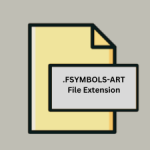.PM3 File Extension

PageMaker 3 Document
| Developer | Adobe Systems |
| Popularity | |
| Category | Raster Image Files |
| Format | .PM3 |
| Cross Platform | Update Soon |
What is an PM3 file?
The .PM3 file extension is associated with PageMaker 3, a desktop publishing software developed by Aldus Corporation, later acquired by Adobe Systems. These files contain documents created with PageMaker 3, typically used for creating layouts, designs, and publishing materials such as newsletters, brochures, and magazines.
More Information.
PageMaker 3 was introduced as a desktop publishing tool aimed at simplifying the process of creating professional-quality publications. The .PM3 file format was designed to store documents created within the software, preserving layout, formatting, and graphical elements.
Origin Of This File.
The .PM3 file format originated from PageMaker 3, which was released in 1987. It was one of the early versions of the software and was widely used in the publishing industry during the late 1980s and early 1990s.
File Structure Technical Specification.
.PM3 files are binary files that store text, images, layout information, and other elements of a PageMaker document. The file structure is proprietary to PageMaker and is optimized for efficient rendering and printing of documents.
How to Convert the File?
Windows:
- Use online conversion services: Several websites offer file conversion services where you can upload your .PM3 file and convert it to a more modern format like PDF or DOC.
- Utilize specialized conversion software: Look for software specifically designed to convert .PM3 files to other formats. Some options may include Adobe Acrobat, Adobe InDesign, or third-party conversion tools.
- Virtualization: Run Adobe PageMaker 3 within a virtual machine on Windows using software like VirtualBox or VMware. Once PageMaker is running, you can open the .PM3 file and export it to a more accessible format.
Linux:
- Virtualization: Set up a virtual machine on Linux using software such as VirtualBox or QEMU and install Windows or macOS within the virtual environment. Then, install Adobe PageMaker 3 and use it to open the .PM3 file for conversion.
- Wine: Use Wine, a compatibility layer for running Windows applications on Linux, to install and run Adobe PageMaker 3. Once installed, open the .PM3 file within PageMaker and save it in a more common format like PDF.
macOS:
- Virtualization: Similar to Linux, set up a virtual machine on macOS using software like VirtualBox or Parallels Desktop. Install Windows within the virtual environment and then install Adobe PageMaker 3 to open and convert the .PM3 file.
- Emulation: Use emulation software like SheepShaver or Basilisk II to emulate older versions of macOS capable of running Adobe PageMaker 3. Once PageMaker is running, open the .PM3 file and save it in a modern format.
Android:
- Online conversion services: Some websites offer mobile-friendly interfaces for file conversion. Upload your .PM3 file to one of these services and convert it to a format compatible with Android devices, such as PDF or DOCX.
- Third-party apps: Look for third-party apps on the Google Play Store that claim to support .PM3 files or offer file conversion functionality. These apps may vary in quality and effectiveness, so be sure to read reviews before downloading.
iOS:
- Online conversion services: Similar to Android, look for online services that offer mobile-friendly conversion options. Upload your .PM3 file and convert it to a format compatible with iOS devices, such as PDF or DOCX.
- Third-party apps: Search the App Store for third-party apps that claim to support .PM3 files or offer file conversion features. Again, read reviews and consider the credibility of the app before downloading.
Others:
- Virtualization or emulation: For other operating systems not covered above, consider using virtualization or emulation software to run Adobe PageMaker 3 and open the .PM3 file for conversion.
- Cross-platform conversion tools: Look for cross-platform conversion tools that may run on a variety of operating systems and support .PM3 file conversion. These tools may be available online or as standalone software packages.
Advantages And Disadvantages.
Advantages:
- Compatibility with PageMaker 3 software.
- Preserves layout and formatting.
- Suitable for printing high-quality documents.
Disadvantages:
- Obsolete format, not widely supported by modern software.
- Limited compatibility with newer operating systems and applications.
- Risk of data loss or corruption due to outdated file format.
How to Open PM3?
Open In Windows
.PM3 files can be opened in Windows using Adobe PageMaker 3, provided that the software is compatible with the version of Windows being used. Alternatively, conversion software or virtualization tools may be used to open .PM3 files on Windows.
Open In Linux
Opening .PM3 files in Linux may require emulation or virtualization software to run Adobe PageMaker 3. Alternatively, conversion tools compatible with Linux may be used to convert .PM3 files to more accessible formats.
Open In MAC
.PM3 files can be opened on macOS using Adobe PageMaker 3 or through emulation software capable of running older Mac applications. Conversion tools may also be used to convert .PM3 files to formats compatible with modern macOS applications.
Open In Android
Opening .PM3 files on Android devices is challenging due to the lack of native support for PageMaker software. However, some third-party apps or online services may offer limited support for viewing or converting .PM3 files on Android.
Open In IOS
Similar to Android, opening .PM3 files on iOS devices is not straightforward. Third-party apps or online services may provide limited support for viewing or converting .PM3 files on iOS.
Open in Others
Other operating systems may require similar approaches for opening .PM3 files, such as emulation, virtualization, or conversion to more compatible formats. Third-party software or online services may offer solutions tailored to specific platforms.













